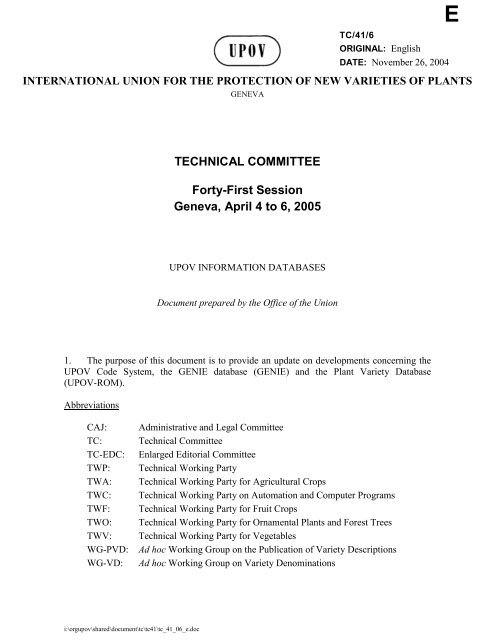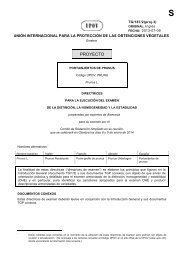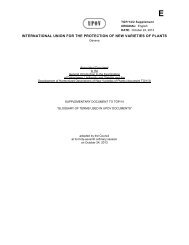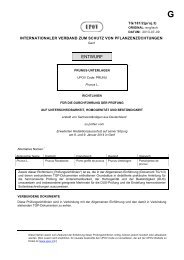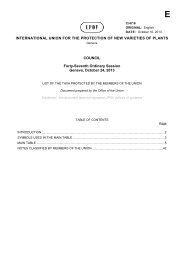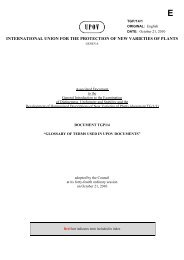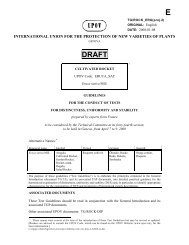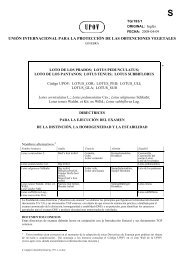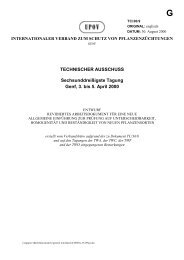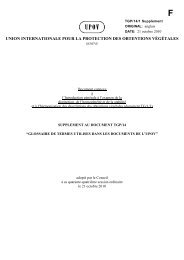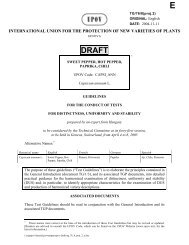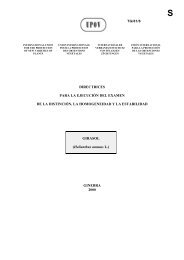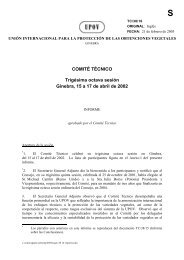TECHNICAL COMMITTEE Forty-First Session Geneva, April 4 to 6 ...
TECHNICAL COMMITTEE Forty-First Session Geneva, April 4 to 6 ...
TECHNICAL COMMITTEE Forty-First Session Geneva, April 4 to 6 ...
You also want an ePaper? Increase the reach of your titles
YUMPU automatically turns print PDFs into web optimized ePapers that Google loves.
TC/41/6<br />
ORIGINAL: English<br />
DATE: November 26, 2004<br />
INTERNATIONAL UNION FOR THE PROTECTION OF NEW VARIETIES OF PLANTS<br />
GENEVA<br />
E<br />
<strong>TECHNICAL</strong> <strong>COMMITTEE</strong><br />
<strong>Forty</strong>-<strong>First</strong> <strong>Session</strong><br />
<strong>Geneva</strong>, <strong>April</strong> 4 <strong>to</strong> 6, 2005<br />
UPOV INFORMATION DATABASES<br />
Document prepared by the Office of the Union<br />
1. The purpose of this document is <strong>to</strong> provide an update on developments concerning the<br />
UPOV Code System, the GENIE database (GENIE) and the Plant Variety Database<br />
(UPOV-ROM).<br />
Abbreviations<br />
CAJ:<br />
TC:<br />
TC-EDC:<br />
TWP:<br />
TWA:<br />
TWC:<br />
TWF:<br />
TWO:<br />
TWV:<br />
WG-PVD:<br />
WG-VD:<br />
Administrative and Legal Committee<br />
Technical Committee<br />
Enlarged Edi<strong>to</strong>rial Committee<br />
Technical Working Party<br />
Technical Working Party for Agricultural Crops<br />
Technical Working Party on Au<strong>to</strong>mation and Computer Programs<br />
Technical Working Party for Fruit Crops<br />
Technical Working Party for Ornamental Plants and Forest Trees<br />
Technical Working Party for Vegetables<br />
Ad hoc Working Group on the Publication of Variety Descriptions<br />
Ad hoc Working Group on Variety Denominations<br />
i:\orgupov\shared\document\tc\tc41\tc_41_06_e.doc
TC/41/6<br />
page 2<br />
UPOV CODE SYSTEM<br />
2. The TC, at its fortieth session held in <strong>Geneva</strong> from March 29 <strong>to</strong> 31, 2004, agreed <strong>to</strong> the<br />
inclusion of UPOV codes in GENIE on the basis of document TC/40/6-CAJ/49/4.<br />
However, the TC noted that there were certain codes which required checking before their<br />
inclusion and that further consideration of coding of intergeneric and interspecific hybrids and<br />
“multiple ranked names” was required before the completion of GENIE could be achieved.<br />
The developments with regard <strong>to</strong> those and other aspects of the UPOV Code System are<br />
explained below.<br />
Checking of Codes<br />
3. With regard <strong>to</strong> those UPOV codes which still required <strong>to</strong> be checked before inclusion in<br />
GENIE, the TC agreed that these should be checked by the appropriate TWP during their<br />
sessions in 2004. The TWPs agreed that the checking of the codes should be undertaken by<br />
the authorities which had contributed data <strong>to</strong> UPOV concerning the genera and species<br />
concerned. To aid the experts in the checking of these codes, the Office of the Union (the<br />
Office) provided an Excel spreadsheet containing all UPOV codes in which the codes <strong>to</strong> be<br />
checked by each expert were highlighted. The Office also clarified the type of checking<br />
which was required by the experts. The TWPs agreed that the experts should submit their<br />
comments by Oc<strong>to</strong>ber 8, 2004, in order that the checked codes could be incorporated in<br />
GENIE, which was used for the generation of Council documents C/38/5 “Cooperation in<br />
examination” and C/38/6 “List of the taxa protected in the member States of UPOV and in the<br />
States and organizations that have initiated the procedure for acceding <strong>to</strong> UPOV and which<br />
have provided information”.<br />
4. Subsequent <strong>to</strong> the checking of the codes by the TC and TWPs in 2004, there has been a<br />
need <strong>to</strong> introduce some new codes and also <strong>to</strong> amend certain codes (see also paragraph 16).<br />
In accordance with the procedure for the introduction and amendment of codes as agreed by<br />
the TC at its fortieth session, reproduced as Annex I <strong>to</strong> this document, those codes will be<br />
presented <strong>to</strong> the relevant TWP(s), as indicated in Annex II, for their consideration. Annex II<br />
is presented in two parts. Part A is a report on the changes made <strong>to</strong> the UPOV codes and<br />
names in GENIE before an au<strong>to</strong>matic report was introduced in<strong>to</strong> GENIE in February 2005.<br />
Part B is the report of changes made since February 1, 2005, using the au<strong>to</strong>matic report<br />
facility in GENIE; this is the format which will be used for reporting all future<br />
amendments <strong>to</strong> the UPOV codes and names.<br />
Intergeneric and Interspecific Hybrids<br />
5. It was noted by some experts that breeding developments can result in intergeneric<br />
hybrids which could result in “grey areas” between genera.<br />
6. The TC, at its fortieth session, agreed that the UPOV code should reflect the taxonomic<br />
classification. Thus, if a genus exists for a hybrid formed between two genera (e.g. Triticale),<br />
the “genus element” of the UPOV code would be based on the “hybrid” genus. Where a<br />
genus for hybrids did not exist, a code would not be created and varieties bred from two<br />
genera would be classified according <strong>to</strong> the available codes. Where confusion concerning<br />
variety denominations could arise, it would be possible <strong>to</strong> create a new variety denomination<br />
class containing, for example, two genera and hybrids between those genera.
TC/41/6<br />
page 3<br />
7. Following the TC session, a further possibility <strong>to</strong> address hybrid genera (and species)<br />
was put forward by the IT expert of the World Intellectual Property Organization (WIPO)<br />
developing GENIE: A new genus (or species) formed as a hybrid between other genera (or<br />
species) would be given a new UPOV code. However, in the database, a link would be made<br />
between the parent genera (or species) and the new hybrid. Thus, when searching, it would be<br />
possible <strong>to</strong> search on a UPOV code, but <strong>to</strong> au<strong>to</strong>matically receive the results on all related<br />
codes:<br />
Example:<br />
Hybrid genus formed between Carlus x Phillipus<br />
Genus<br />
Carlus<br />
Phillipus<br />
Carlus x Phillipus<br />
UPOV Code<br />
CARLU_(linked <strong>to</strong> CAPHI_)<br />
PHILL_(linked <strong>to</strong> CAPHI_)<br />
CAPHI_(linked <strong>to</strong> CARLU_ and PHILL_)<br />
A search on “CARLU” (Carlus) would au<strong>to</strong>matically provide all varieties of Carlus and the<br />
hybrid genus Carlus x Phillipus. A search on “PHILL” (Phillipus) would au<strong>to</strong>matically<br />
provide all varieties of Phillipus and the hybrid genus Carlus x Phillipus. A search on<br />
“CAPHI” (Carlus x Phillipus) would provide all varieties of Carlus, Phillipus and the hybrid<br />
genus Carlus x Phillipus. Thus, for example, if it was the case that Carlus and Phillipus were<br />
in different variety denomination classes, the hybrid could, if required, be considered in both<br />
classes.<br />
8. Annex III <strong>to</strong> this document provides an example of how the information on linked codes<br />
is presented in a report generated from GENIE. The relationship is shown as “parent” (e.g.<br />
CARLU and PHILL above) and “hybrid” (e.g. CAPHI above). It should be noted that the<br />
UPOV codes currently distinguish between two hybrids produced using the same parents, but<br />
with the male and female parents reversed, e.g.:<br />
PRUNU_DPE:<br />
PRUNU_PDA:<br />
Prunus davidiana (PRUNU_DAV) x Prunus persica (PRUNU_PER)<br />
Prunus persica (PRUNU_PER) x Prunus davidiana (PRUNU_DAV).<br />
However, a single code could be used <strong>to</strong> cover such hybrids if required.<br />
9. Linkages are only used for “hybrids” which are not taxonomically recognized as genera<br />
or species in their own right. Thus, Agrotriticum is a “hybrid” between Agropyron and<br />
Triticum, but it is botanically recognized and, therefore, no linkages are proposed for these<br />
codes.<br />
10. The proposal for creating codes for hybrids which are not botanically recognized as<br />
genera or species in their own right has been considered and approved by the TWPs at their<br />
sessions in 2004 and will be the working basis for the UPOV Code System and GENIE,<br />
subject <strong>to</strong> approval by the TC.<br />
Multiple-Ranked Names: Brassica and Beta<br />
11. At its fortieth session, the TC noted that a proposal from the rapporteur of the ICNCP<br />
(see document TC/40/10, paragraph 15) <strong>to</strong> use a grouping system of classification for
TC/41/6<br />
page 4<br />
Brassica and Beta appeared <strong>to</strong> have potential advantages. However, it was also noted that,<br />
until now, UPOV had not used this system in relation <strong>to</strong> naming for variety denomination<br />
classes and Test Guidelines. Nevertheless, it recognized that once the codes were adopted it<br />
would be difficult <strong>to</strong> introduce a change at a later time, and it therefore proposed that this<br />
matter should be considered by the TC before the codes were finalized. To avoid delay in<br />
finalizing the codes, it agreed that the Office, in conjunction with the chairmen of the TC, the<br />
TWA and the TWV, should develop a proposal for consideration by the TWA, the TWV and<br />
the WG-VD. If the proposal was agreed by all parties, this would be the basis for codes for<br />
Beta and Brassica. In the absence of agreement by all parties, the code would be based on the<br />
proposals presented in Annexes I and II of document TC/40/6-CAJ/49/4.<br />
12. In accordance with that approach, an agreement was reached <strong>to</strong> base the codes on a<br />
grouping classification for part of the Beta and Brassica genera. Thus, a grouping<br />
classification will be used for codes within Beta vulgaris and part of Brassica oleracea. To<br />
indicate that a grouping classification is being used for those two species, the first letter of the<br />
third element of the code will start with “G”. A summary of the structuring of the species is<br />
presented below:<br />
UPOV CODE BOTANICAL NAME COMMON NAME<br />
BETAA_VUL Beta vulgaris L.<br />
BETAA_VUL_GV Beta vulgaris L. ssp. vulgaris Beet<br />
BETAA_VUL_GVA Beta vulgaris L. ssp. vulgaris var. alba DC. Fodder beet<br />
BETAA_VUL_GVC Beta vulgaris L. ssp. vulgaris var. conditiva Alef. Beetroot<br />
BETAA_VUL_GVF Beta vulgaris L. ssp. vulgaris var. flavescens DC. Leaf beet<br />
BETAA_VUL_GVS Beta vulgaris L. ssp. vulgaris var. saccharifera Alef. Sugar beet<br />
BRASS_OLE_GA Brassica oleracea L. convar. acephala (DC.) Alef. Kale<br />
BRASS_OLE_GAM Brassica oleracea L. convar. acephala (DC.) Alef. var. medullosa Thell. Marrow-stem kale<br />
BRASS_OLE_GAR Brassica oleracea L. var. ramosa DC. Catjang<br />
BRASS_OLE_GAS Brassica oleracea L. convar. acephala (DC.) Alef. var. sabellica L. Curly kale<br />
BRASS_OLE_GAV Brassica oleracea L. convar. acephala (DC.) Alef. var. viridis L. Fodder kale<br />
BRASS_OLE_GB<br />
Brassica oleracea L. convar. botrytis (L.) Alef.<br />
BRASS_OLE_GBB Brassica oleracea L. convar. botrytis (L.) Alef. var. botrytis Cauliflower<br />
BRASS_OLE_GBC Brassica oleracea L. convar. botrytis (L.) Alef. var. cymosa Duch. Broccoli<br />
BRASS_OLE_GC<br />
BRASS_OLE_GCA<br />
BRASS_OLE_GCR<br />
Brassica oleracea L. convar. capitata (L.) Alef. var. capitata (L.) Alef. Cabbage<br />
Brassica oleracea L. convar. capitata (L.) Alef. var. capitata L. f. alba DC. White cabbage<br />
Brassica oleracea L. convar. capitata (L.) Alef. var. capitata L. f. rubra<br />
(L.) Thell.<br />
Red cabbage<br />
BRASS_OLE_GCS Brassica oleracea L. convar. capitata (L.) Alef. var. sabauda L. Savoy cabbage<br />
BRASS_OLE_GGM Brassica oleracea L. convar. oleracea var. gemmifera DC. Brussels sprout<br />
BRASS_OLE_GGO Brassica oleracea L. convar. acephala (DC.) Alef. var. gongylodes L. Kohlrabi
TC/41/6<br />
page 5<br />
Variety Types<br />
13. Whilst developing GENIE, it has become apparent that it may be useful <strong>to</strong> be able <strong>to</strong><br />
identify types within a genus or species. Thus, for example in the case of apple, there are<br />
separate Test Guidelines for fruit varieties (TG/14), for roots<strong>to</strong>ck varieties (TG/163) and for<br />
ornamental varieties (TG/192). Also, when reporting for document TC/41/4 “List of species<br />
in which practical knowledge has been acquired or for which national test guidelines have<br />
been established”, authorities sometimes indicate that their experience only relates <strong>to</strong> certain<br />
types of variety. The basis of the UPOV code is a “vertical” botanical classification and,<br />
therefore, the UPOV code is limited in its scope <strong>to</strong> differentiate, in a “horizontal” way, types<br />
of variety (e.g. fruit varieties and ornamental varieties) which have the same botanical<br />
classification. However, it is possible <strong>to</strong> provide notes indicating this additional information<br />
and it would also be possible within GENIE <strong>to</strong> identify such “types” within a code. Thus, if<br />
types are created within a UPOV code within GENIE, it would be possible <strong>to</strong> search<br />
“MALUS” for all information related <strong>to</strong> apple, but also <strong>to</strong> refine the search, for example for<br />
all information which is specifically indicated as relating <strong>to</strong> fruit varieties only. That facility<br />
could also be incorporated in<strong>to</strong> the web-based version of the Plant Variety Database, although<br />
it will not be possible for it <strong>to</strong> be incorporated in<strong>to</strong> the current CD-ROM version. The Office<br />
is currently evaluating whether it would be most appropriate simply <strong>to</strong> provide notes in<br />
relation <strong>to</strong> certain information, or whether <strong>to</strong> create the facility <strong>to</strong> identify types within a<br />
UPOV code in GENIE and will report on its considerations at the forty-first session of<br />
the TC.<br />
Program for Introduction of UPOV Codes<br />
14. The TC agreed, at its fortieth session, that members of the Union and other contribu<strong>to</strong>rs<br />
should be encouraged <strong>to</strong> start <strong>to</strong> use the UPOV codes when contributing data <strong>to</strong> the<br />
UPOV-ROM as soon as GENIE was made available on the UPOV website and agreed that,<br />
in the first instance, such use would be optional.<br />
15. The pro<strong>to</strong>type GENIE has been developed and is being used within the UPOV Office,<br />
but it is not envisaged that it will be launched on the UPOV website before the end of 2005,<br />
for the reasons explained below (see paragraph 22). However, the necessary information on<br />
UPOV codes is already available and could be presented on the UPOV website for use by<br />
contribu<strong>to</strong>rs <strong>to</strong> the UPOV-ROM. A test-run has been undertaken with the Community Plant<br />
Variety Office (CPVO) as a part of the cooperation in the development and maintenance of<br />
the UPOV web-based Plant Variety Database and the CPVO Centralized Database on Variety<br />
Denominations (“the CPVO variety denomination database”) (see paragraphs 23 and 24<br />
below).<br />
16. A list of codes <strong>to</strong>gether with the relevant botanical and common names was supplied <strong>to</strong><br />
the CPVO on November 23, 2004, for use in the development of the CPVO variety<br />
denomination database. The CPVO requested that, for future lists, the principal botanical<br />
name, used as the basis for the UPOV code, and the variety denomination class for each<br />
UPOV code should also be provided. In February 2005, after having checked the list of codes<br />
in the November list, the CPVO identified some further 90 genera or species which were not<br />
included in GENIE. Codes for those genera and species were introduced in GENIE and are<br />
included in Annex II, Part B. A new extract was made from GENIE and sent <strong>to</strong> the CPVO<br />
with the following information provided in the form of Excel spreadsheets:
TC/41/6<br />
page 6<br />
Spreadsheet 1: UPOV code list (one line per UPOV code)<br />
UPOV code Principal Botanical Name Variety Denomination Class<br />
ABELI Abelia R. Br. ABELI<br />
ABELI_GRA Abelia x grandiflora Rehder ABELI<br />
ABELM Abelmoschus ABELM<br />
ABELM_ESC Abelmoschus esculentus (L.) Moench ABELM<br />
ABIES Abies Mill. Class 19<br />
ABIES_ALB Abies alba Mill. Class 19<br />
etc.<br />
Spreadsheet 2: Full list of names by UPOV code<br />
UPOV code Language Name<br />
ABELI Latin Abelia R. Br.<br />
ABELI English Abelia<br />
ABELI French Abelia<br />
ABELI German Abelia<br />
ABELI Spanish Abelia<br />
ABELI_GRA Latin Abelia x grandiflora Rehder<br />
ABELM Latin Abelmoschus<br />
ABELM_ESC Latin Abelmoschus esculentus (L.) Moench<br />
ABELM_ESC Latin Hibiscus esculentus L.<br />
ABELM_ESC English Gombo<br />
ABELM_ESC French Ambrette<br />
ABELM_ESC German Okra<br />
ABELM_ESC Spanish Okra<br />
etc.<br />
Spreadsheet 3: Hybrid and linked codes<br />
Hybrid UPOV Code<br />
AMARA_HCR<br />
AMARA_HCR<br />
BORON_HME<br />
BORON_HME<br />
BRCHY_ACU<br />
BRCHY_ACU<br />
etc.<br />
Parent UPOV Code<br />
AMARA_CRU<br />
AMARA_HYP<br />
BORON_HET<br />
BORON_MEG<br />
BRCHY_ASC<br />
BRCHY_CUR
TC/41/6<br />
page 7<br />
17. A summary of changes <strong>to</strong> the previous version was also provided. In addition <strong>to</strong> the<br />
spreadsheets above, which are intended <strong>to</strong> provide data in a manageable form for<br />
downloading in<strong>to</strong> a database, two consolidated reports of the same information were prepared<br />
in pdf format for general reference. An extract of these reports is presented as Annex IV.<br />
18. It is proposed that, subject <strong>to</strong> the agreement of the TC and the CAJ, the spreadsheets<br />
and the pdf reports, as set out above, will be posted on the first restricted area of the UPOV<br />
website. Contribu<strong>to</strong>rs <strong>to</strong> the UPOV-ROM would be notified by e-mail each time the<br />
information is updated and would be able <strong>to</strong> download the revised complete spreadsheets or<br />
the changes <strong>to</strong> the previous versions. Contribu<strong>to</strong>rs could then use that information <strong>to</strong> include<br />
the UPOV codes when submitting data <strong>to</strong> the UPOV-ROM.<br />
19. It is recognized that some contribu<strong>to</strong>rs may wish <strong>to</strong> receive assistance in the process of<br />
introducing UPOV codes for their UPOV-ROM data. The Office is currently assessing two<br />
possible forms of assistance:<br />
(a)<br />
Initial assistance<br />
At the point at which a contribu<strong>to</strong>r indicates their intention <strong>to</strong> start using the<br />
UPOV code in their UPOV-ROM data, the Office would take the most recent batch of<br />
data provided by the contribu<strong>to</strong>r concerned (initial batch) and return that data <strong>to</strong> the<br />
contribu<strong>to</strong>r with the relevant UPOV codes. For future submission, the contribu<strong>to</strong>r<br />
would only have <strong>to</strong> identify the UPOV codes for genera and species not already<br />
provided with a code in the initial batch.<br />
(b)<br />
Full assistance<br />
The contribu<strong>to</strong>r would continue submitting data without the UPOV code. The<br />
Office would attribute all the relevant UPOV codes on receiving the data.<br />
20. The scope for the Office <strong>to</strong> provide the type of assistance set out above will depend on<br />
the number of contribu<strong>to</strong>rs requesting such assistance and the success of the Office in finding<br />
ways <strong>to</strong> au<strong>to</strong>mate the allocation of UPOV codes <strong>to</strong> the data it receives. The Office will report<br />
on progress in au<strong>to</strong>mating the allocation of codes at the forty-first session of the TC and<br />
fifty-first session of the CAJ. It would be very helpful, at that stage, if contribu<strong>to</strong>rs could<br />
indicate what, if any, assistance they would require in introducing UPOV codes when<br />
submitting their data for the UPOV-ROM.<br />
GENIE<br />
21. It is recalled that GENIE is being developed <strong>to</strong> provide, for example, online information<br />
on the status of protection (see document C/38/6), cooperation in examination (see document<br />
C/38/5), experience in DUS testing (see document TC/41/4), and existence of UPOV Test<br />
Guidelines (see document TC/41/2) for different GENera and specIEs (hence GENIE), and<br />
will also be used <strong>to</strong> generate the relevant Council and TC documents concerning that<br />
information. In addition, GENIE is the reposi<strong>to</strong>ry of the UPOV codes and will be used <strong>to</strong><br />
provide the botanical names, common names and variety denomination class for the purposes<br />
of the Plant Variety Database.
TC/41/6<br />
page 8<br />
22. The pro<strong>to</strong>type GENIE in Microsoft Access format has now been populated with all<br />
available UPOV codes and corresponding information relating <strong>to</strong> the documents mentioned in<br />
paragraph 21 except, as of January 31, 2005, the information concerning relevant Test<br />
Guidelines (document TC/41/2). Initially, the intention was <strong>to</strong> launch GENIE on the UPOV<br />
website at this stage. However, because there are so many types of information contained<br />
within GENIE, it has become apparent that the design of the user interface (e.g. site<br />
navigation, query options, printable reports, downloads, etc.) is very important for its<br />
usability. It is also recognized that it would be very difficult <strong>to</strong> make any further<br />
modifications once the web-based version of GENIE has been designed and implemented.<br />
Therefore, an advanced pro<strong>to</strong>type, mimicking a web-based version, is being developed and<br />
evaluated within the UPOV Office for its suitability in response <strong>to</strong> requests for information<br />
received in the Office, before a commitment is made <strong>to</strong> the design of the web-based version.<br />
It is planned that a pro<strong>to</strong>type will be demonstrated at the forty-first session of the TC and<br />
fifty-first session of the CAJ. Any comments or suggestions regarding the design will be<br />
taken in<strong>to</strong> account before the design of the web-based version is finalized.<br />
PLANT VARIETY DATABASE<br />
23. At the fortieth session of the TC and forty-ninth session of the CAJ (see document<br />
TC/40/6–CAJ/49/4), it was explained that a fac<strong>to</strong>r which had been taken in<strong>to</strong> account in the<br />
program <strong>to</strong> improve the Plant Variety Database was the project for a centralized database on<br />
variety denominations being undertaken by the CPVO. That project is intended <strong>to</strong> develop a<br />
web-based database for variety denomination examination purposes, but relies on a database<br />
of information which should be essentially the same as that of the UPOV Plant Variety<br />
Database. It was recognized that there would be mutual benefit if both parties cooperated in<br />
the work. In that regard, it was reported that a Memorandum of Understanding was under<br />
development for cooperation in the development and maintenance of a UPOV web-based<br />
Plant Variety Database and the CPVO variety denomination database in a way which would<br />
minimize the overall cost of development of software and maintenance of data, maximize the<br />
completeness of the UPOV and CPVO databases, and secure compatibility of both databases.<br />
24. Some of the key aspects of the Memorandum of Understanding, which was signed in<br />
Oc<strong>to</strong>ber 2004, are as follows:<br />
(a)<br />
Database Software<br />
In the first instance, CPVO will provide UPOV (“the Parties”) with its proposed<br />
database model and data dictionary. In the second instance, UPOV will offer initial<br />
comments and suggestions with regard <strong>to</strong> compatibility of the software for the<br />
UPOV database. Subsequent collaboration between the Parties in any refinement <strong>to</strong> the<br />
CPVO proposal will take the form of meetings and/or exchange of correspondence as<br />
considered appropriate by the Parties. Following this process, CPVO will develop its<br />
database software. The database software that CPVO decides <strong>to</strong> use and release (the<br />
“CPVO software”) will, subject <strong>to</strong> certain conditions, be offered <strong>to</strong> UPOV free of<br />
charge. CPVO will inform UPOV of subsequent updates of the CPVO software.<br />
UPOV will advise CPVO on whether it wishes <strong>to</strong> use the CPVO software or whether it<br />
will develop its own software (the “UPOV software”). If UPOV decides <strong>to</strong> develop its<br />
own software, it will provide CPVO with its proposed database model and data
TC/41/6<br />
page 9<br />
dictionary in order <strong>to</strong> seek comments and suggestions with regard <strong>to</strong> compatibility of<br />
the software for the CPVO database.<br />
(b)<br />
Maintenance of Data<br />
The responsibility for providing data would be as follows:<br />
(i) subject <strong>to</strong> the agreement of the countries and owners of other registers<br />
concerned, CPVO is <strong>to</strong> be responsible for variety denomination data for all<br />
official registers kept by authorities of the Member States of the European Union,<br />
official registers kept by authorities of the European Economic Area (EEA) and<br />
Switzerland, the European Union Common Catalogues and other relevant<br />
registers, such as the Dutch database PLANTSCOPE;<br />
(ii) UPOV is <strong>to</strong> be responsible for variety denomination data for all official<br />
registers kept by authorities of members of the Union which are not mentioned<br />
in (i). UPOV is also <strong>to</strong> be responsible for data from international organizations<br />
(e.g. Organisation for Economic Co-operation and Development (OECD)); and<br />
(iii)<br />
for other data, <strong>to</strong> be agreed by the Parties on a case-by-case basis.<br />
(c)<br />
Use of Data by UPOV and CPVO<br />
UPOV will retain the possibility of charging parties other than UPOV members<br />
and contribu<strong>to</strong>rs <strong>to</strong> the database (“third party users”) for the use of any future database.<br />
The use of the CPVO database will be restricted <strong>to</strong> checking variety denominations for<br />
compliance with the requirements of the Community Plant Variety Rights (CPVR)<br />
system. In the first instance, use will be confined <strong>to</strong> contribu<strong>to</strong>rs of data, comprising<br />
CPVO, national authorities and other data providers (e.g. PLANTSCOPE). However, it<br />
is possible that, in future, other parties, including breeders, would be granted use of the<br />
database. CPVO will retain the possibility of providing the database not only <strong>to</strong><br />
contribu<strong>to</strong>rs <strong>to</strong> the database but also <strong>to</strong> third party users, free of charge.<br />
(d)<br />
Access <strong>to</strong> Raw Data for Third Parties<br />
The UPOV policy is that raw data will be available <strong>to</strong> members of the Union and<br />
contribu<strong>to</strong>rs of data, but will not be available <strong>to</strong> other parties. The CPVO policy is that<br />
raw data will be available <strong>to</strong> the relevant authorities of the Member States of the<br />
European Union and other organizations contributing data, but will not be available <strong>to</strong><br />
other parties.<br />
(e)<br />
Creation of UPOV Codes for “New” Species in the Database<br />
UPOV is responsible for the creation and maintenance of UPOV codes and will develop<br />
a procedure for the introduction and maintenance of codes in a timely way.<br />
25. At the fortieth session of the TC and forty-ninth session of the CAJ, the Office reported<br />
that it would present an initial pro<strong>to</strong>type of its web-based Plant Variety Database at the<br />
forty-first session of the TC and fifty-first session of the CAJ, <strong>to</strong>gether with proposals<br />
concerning the fields <strong>to</strong> be included and proposals for which fields might be considered <strong>to</strong> be<br />
manda<strong>to</strong>ry. The TC considered that the matter of frequency of updating of the web-based
TC/41/6<br />
page 10<br />
Plant Variety Database should be considered in conjunction with the presentation of the<br />
pro<strong>to</strong>type and that consideration of the establishment of links <strong>to</strong> relevant websites for variety<br />
denomination checking purposes could also be considered at that time. In relation <strong>to</strong> the<br />
possibilities for manual inputting of data from printed gazettes, the TC noted that improving<br />
the ease of contributing data was likely <strong>to</strong> increase the number of countries contributing data<br />
and that it would be appropriate <strong>to</strong> assess the need for manual input of data at a later stage.<br />
26. The TC, at its fortieth session, and the CAJ, at its forty-ninth session, further agreed<br />
that, in the light of developments concerning a web-based Plant Variety Database, the planned<br />
short-term improvements <strong>to</strong> the UPOV-ROM should not be pursued. However, it was agreed<br />
that training for the purposes of contributing data <strong>to</strong> the Plant Variety Database and for its use<br />
should go ahead. The Office explained that the UPOV-ROM would continue <strong>to</strong> be produced<br />
on the current basis and that, for some users, a CD-ROM media may offer advantages<br />
compared <strong>to</strong> a web-based system. The Office confirmed that it would not discontinue the<br />
production of the UPOV-ROM without further consultation.<br />
27. In response <strong>to</strong> the discussions at the fortieth session of the TC and forty-ninth session of<br />
the CAJ, in particular, the wish that the Plant Variety Database should continue <strong>to</strong> be<br />
produced in its current UPOV-ROM format for the foreseeable future, even if a web-based<br />
version is developed alongside, the Office has reviewed its planned program. Instead of<br />
focussing work on the development of the new web-based media, priority has been focussed<br />
on improvements which can equally be realized in the UPOV-ROM format, namely:<br />
(a)<br />
introduction of the UPOV code: proposals are set out in paragraph 18 above;<br />
(b) improving the ease of contributing data <strong>to</strong> the UPOV-ROM: the Office is<br />
developing a data submission table which will provide all the necessary information for the<br />
UPOV-ROM without the use of TAG format. As soon as that table is finalized, contribu<strong>to</strong>rs<br />
will be informed and the table will be provided on the first restricted area of the UPOV<br />
website;<br />
(c) providing training in the use of the UPOV-ROM: Information on the use of the<br />
UPOV-ROM and how <strong>to</strong> contribute data is now being included in the Workshop on Data<br />
Handling, which is occasionally offered in conjunction with the TWC sessions. A copy of the<br />
lecture provided at the workshop held in Beijing from June 9 <strong>to</strong> 11, 2004, can be found on the<br />
UPOV website at: http://www.upov.int/en/publications/pdf/upov_data_bei_04_11.pdf.<br />
28. The schedule for the development of an initial pro<strong>to</strong>type of the web-based Plant Variety<br />
Database will depend on the resources needed <strong>to</strong> advance the three priorities set out above. In<br />
particular, the level of assistance needed for contribu<strong>to</strong>rs in relation <strong>to</strong> the introduction of the<br />
UPOV code will determine how quickly it will be possible <strong>to</strong> start working on the web-based<br />
Plant Variety Database. If possible, a pro<strong>to</strong>type will be presented at the forty-second session<br />
of the TC and the fifty-third session of the CAJ, <strong>to</strong>gether with proposals concerning the fields<br />
<strong>to</strong> be included and proposals for which fields might be considered <strong>to</strong> be manda<strong>to</strong>ry, as<br />
requested by the TC at its fortieth session. The frequency of updating of the web-based Plant<br />
Variety Database will be considered in conjunction with the presentation of the pro<strong>to</strong>type<br />
<strong>to</strong>gether with consideration of the establishment of links <strong>to</strong> relevant websites for variety<br />
denomination checking purposes.
TC/41/6<br />
page 11<br />
29. The TC is invited <strong>to</strong>:<br />
(a) note that the relevant TWP(s) will<br />
be invited <strong>to</strong> check amendments <strong>to</strong> the codes in<br />
GENIE, as set out in Annex II (see<br />
paragraph 4);<br />
(b) approve the proposals for UPOV<br />
codes in relation <strong>to</strong> intergeneric and<br />
interspecific hybrids, as set out in paragraphs<br />
7 <strong>to</strong> 10;<br />
(c) approve the proposals for UPOV<br />
codes on the basis of groups within Beta<br />
vulgaris and part of Brassica oleracea, as set<br />
out in paragraph 12;<br />
(d) note that the Office will report on<br />
its considerations in relation <strong>to</strong> providing<br />
information in relation <strong>to</strong> different types of<br />
variety within the same UPOV code, as set out<br />
in paragraph 13;<br />
(e) consider the proposals for making<br />
the UPOV codes available for use by<br />
contribu<strong>to</strong>rs <strong>to</strong> the UPOV-ROM by their<br />
publication on the UPOV website, as set out in<br />
paragraph 18;<br />
(f) note that the Office will report <strong>to</strong><br />
the forty-first session of the TC on the<br />
possibilities for au<strong>to</strong>mation of UPOV code<br />
allocation <strong>to</strong> UPOV-ROM data, as explained<br />
in paragraph 20;<br />
(g) invite contribu<strong>to</strong>rs <strong>to</strong> the UPOV-<br />
ROM <strong>to</strong> comment on what, if any, assistance<br />
they would require in introducing UPOV<br />
codes when submitting their data, as set out in<br />
paragraph 20;<br />
(h) note the program for launching<br />
GENIE on the UPOV website as set out in<br />
paragraph 22;<br />
(i) comment on the proposed program<br />
for the improvement of the Plant Variety<br />
Database, as set out in paragraphs 27 and 28.<br />
[Annex I follows]
TC/41/6<br />
ANNEX I<br />
PROCEDURE FOR THE INTRODUCTION AND<br />
AMENDMENT OF UPOV CODES<br />
The Technical Committee at its fortieth session, held in <strong>Geneva</strong> from March 29 <strong>to</strong> 31, 2004<br />
(see document TC/40/10, paragraph 17) agreed <strong>to</strong> the following procedure for the introduction<br />
and amendment of codes:<br />
(1) Responsibility for the UPOV Code System<br />
The Office is responsible for the UPOV Code System and the individual codes.<br />
(2) Reposi<strong>to</strong>ry of UPOV Codes<br />
The definitive collection of UPOV codes exists exclusively in the GENIE database.<br />
(3) Introduction of New UPOV Codes / Amendments <strong>to</strong> UPOV Codes<br />
(a) In the first instance, the Office will draft a code on the basis of the Germplasm<br />
Resources Information Network (GRIN) database, or other suitable references if the species<br />
concerned are not included in the GRIN database.<br />
(b) Where the Office is aware of relevant experts for the genus or species concerned,<br />
or is advised of such experts, for example by the proposer of a new code, it will, wherever<br />
possible, check its proposals with those experts before creating the code.<br />
(c) New codes might be proposed by any party, but it is expected that the majority of<br />
proposals will be made by contribu<strong>to</strong>rs <strong>to</strong> the Plant Variety Database. Where the Office<br />
receives such proposals, it will respond by updating the GENIE database with the new codes<br />
in a timely manner and, in particular, will seek <strong>to</strong> ensure that new codes are available <strong>to</strong> allow<br />
their use for the forthcoming edition of the Plant Variety Database. In addition, the Office<br />
will add new codes where it identifies a need.<br />
(d) In general, amendments <strong>to</strong> codes will not be made as a result of taxonomic<br />
developments unless these result in a change <strong>to</strong> the genus classification of a species. The<br />
UPOV recommendations on variety denominations are based on the general principle that,<br />
unless the list of classes applies, all taxonomic units which belong <strong>to</strong> the same genus are<br />
closely related. Therefore, it is important that the first element of the code can be used <strong>to</strong> sort<br />
species in<strong>to</strong> the correct genus. The codes will also be amended if there are consequences for<br />
the content of a variety denomination class where the list of classes applies. Amendments <strong>to</strong><br />
UPOV codes will be handled by the same procedure as the introduction of new codes as in<br />
paragraphs (a) and (b), above. However, in addition, all members of the Union and<br />
contribu<strong>to</strong>rs of data <strong>to</strong> the Plant Variety Database will be informed of any amendments.<br />
(e) New and amended codes will be presented <strong>to</strong> the relevant TWP(s) for comment at<br />
their first available session. If the TWP recommends any change, this will be treated as an<br />
amendment according <strong>to</strong> paragraph (d), above.
TC/41/6<br />
Annex I, page 2<br />
(4) Updating of Information Linked <strong>to</strong> UPOV Codes<br />
(a) UPOV codes might need <strong>to</strong> be updated <strong>to</strong> take account of, for example, changes in<br />
taxonomic classification, new information on common names, etc. In the case of changes of<br />
taxonomic classification, this might, although it is emphasized that this is not necessarily the<br />
case (see section (3)(d), above), result in a need <strong>to</strong> change the UPOV code. In such cases, the<br />
procedure is as explained in section (3), above. In other cases, the Office will amend the<br />
information linked <strong>to</strong> the existing code as appropriate.<br />
(b) The TC, the TWPs and individual communications from members and observers<br />
of these bodies will be the principal routes by which the Office will update its information.<br />
[Annex II follows]
TC/41/6<br />
ANNEX II - Part A<br />
CHANGES MADE TO THE CODES AND NAMES IN GENIE<br />
(before an au<strong>to</strong>matic report facility was introduced in<strong>to</strong> GENIE in February 2005)<br />
Modification<br />
Modification<br />
ref. TWA TWF TWO<br />
Checking TWP<br />
TWV<br />
Checking Country<br />
Denom.<br />
class<br />
Parent codes UPOV Code Botanical name Common Name Nom commun<br />
Landesüblicher<br />
Name<br />
Nombre común<br />
TWO AU, GB, NZ, QZ, RU, US OPHIO_JAB Ophiopogon jaburan (Siebold)<br />
G. Lodd.<br />
TWO AU, GB, NZ, QZ, RU, US OPHIO_JAB Slateria jaburan Siebold<br />
original mod 1(a) TWO AU, GB, NZ, QZ, RU, US LIRIP_ Liriope gigantea<br />
modified mod 1(a) TWO AU, GB, NZ, QZ, RU, US OPHIO_JAB Liriope gigantea<br />
original mod 1(b) TWO AU, GB, NZ, QZ, RU, US LIRIP_ Liriope gigantean<br />
modified mod 1(b) TWO AU, GB, NZ, QZ, RU, US OPHIO_JAB Liriope gigantean<br />
new new 1 TWO AU, GB, NZ, QZ, RU, US LIRIP_SPI Liriope spicata (Thunb.) Lour. creeping liriope<br />
new new 2 TWO CA, GB, QZ MECAR_ Mecardonia Ruiz et Pav.<br />
new new 3 TWO GB, JP, QZ SAXIF_ARE Saxifraga × arendsii Engl.<br />
new new 4(a) TWO DE, JP, KG, QZ, RU ABIES_SIB Abies sibirica Ledeb. Siberian fir sapin de<br />
Sibérie<br />
new new 4(b) TWO DE, JP, KG, QZ, RU ABIES_SIB_SEM Abies sibirica Ledeb. subsp.<br />
semenovii (B. Fedtsch.) Farjon<br />
new new 4(c) TWO DE, JP, KG, QZ, RU ABIES_SIB_SEM Abies semenovii B. Fedtsch.<br />
sibirische Tanne<br />
new new 5(a) TWO KG, RU, US BASSI_PRO Bassia prostrata (L.) A. J.<br />
Scott<br />
new new 5(b) TWO KG, RU, US BASSI_PRO Kochia prostrata (L.) Schrad.<br />
forage kochia<br />
original mod 2(a) TWO KG, RU, US KOCHI_SCO Bassia scoparia (L.) A. J. Scott<br />
modified mod 2(a) TWO KG, RU, US BASSI_SCO Bassia scoparia (L.) A. J. Scott burningbush, kochia,<br />
Mexican firebrush,<br />
Mexican fireweed,<br />
mock cypress,<br />
summer-cypress<br />
Besenkraut<br />
mirabel<br />
original mod 2(b) TWO KG, RU, US KOCHI_SCO * Kochia scoparia (L.) Schrad. Belvedere Summer<br />
Cypress<br />
Kochia<br />
Besenkraut,<br />
Besensommerz<br />
ypresse<br />
Mirabel, Ciprés<br />
de verano<br />
modified mod 2(b) TWO KG, RU, US BASSI_SCO * Kochia scoparia (L.) Schrad. Belvedere Summer<br />
Cypress<br />
Kochia<br />
Besenkraut,<br />
Besensommerz<br />
ypresse<br />
Mirabel, Ciprés<br />
de verano<br />
new new 6 TWF KG, All MALUS_SIE Malus sieversii (Ledeb.) M.<br />
Roem.<br />
new new 7 TWO AU, CA, DE, GB, KG,<br />
NL, PL, QZ, RU, US<br />
PICEA_SCH Picea schrenkiana Fisch. & C.<br />
A. Mey.<br />
Asian spruce, Schrenk<br />
spruce
TC/41/6<br />
Annex II - Part A, page 2<br />
Modification<br />
Modification<br />
ref. TWA TWF TWO<br />
Checking TWP<br />
TWV<br />
Checking Country<br />
Denom.<br />
class<br />
Parent codes UPOV Code Botanical name Common Name Nom commun<br />
Landesüblicher<br />
Name<br />
Nombre común<br />
new new 8(a) TWF KG, All PRUNU_CSF_DIV Prunus cerasifera Ehrh. var.<br />
divaricata (Ledeb.) L. H. Bailey<br />
new new 8(b) TWF KG, All PRUNU_CSF_DIV Prunus sogdiana Vassilcz.<br />
new new 9(a) TWO NL, SG MOKAR_ Mokara<br />
new new 9 (b) TWO NL, SG MOKAR_ Arachnis x Ascocentrum x<br />
Vanda<br />
new new 10 TWO NL, SG ARAND_ × Aranda Hort.<br />
new new 11 TWO NL, SG ARANT_ × Aranthera Hort.<br />
new new 12 TWO NL, SG RENTD_ × Renantanda Hort.<br />
new new 13 TWO AU, SG ANUBI_ Anubias Schott<br />
new new 14(a) TWF TWV JO TRCOS_CUC_ANG Trichosanthes cucumerina L.<br />
var. anguina (L.) Haines<br />
new new 14(b) TWF TWV JO TRCOS_CUC_ANG Trichosanthes anguina L.<br />
club gourd, serpent<br />
gourd, serpentcucumber,<br />
snake<br />
gourd, viper's gourd<br />
new TWO AU, CA, DE, GB, JP, NZ,<br />
PL, QZ, RU, SK, UA, US,<br />
ZA<br />
XEROC_BRA<br />
Xerochrysum bracteatum<br />
(Vent.) Tzvelev<br />
golden everlasting,<br />
paper-flower,<br />
strawflower, yellow<br />
paper daisy<br />
original mod 3(a) TWO AU, CA, DE, GB, JP, NZ,<br />
PL, QZ, RU, SK, UA, US,<br />
ZA<br />
HLCRS_BRA<br />
Bracteantha bracteatum<br />
(Vent.) Anderb. et Haegi<br />
modified mod 3(a) TWO AU, CA, DE, GB, JP, NZ,<br />
PL, QZ, RU, SK, UA, US,<br />
ZA<br />
XEROC_BRA<br />
Bracteantha bracteatum<br />
(Vent.) Anderb. et Haegi<br />
original mod 3(b) TWO AU, CA, DE, GB, JP, NZ,<br />
PL, QZ, RU, SK, UA, US,<br />
ZA<br />
HLCRS_BRA<br />
* Helichrysum bracteatum<br />
(Vent.) Andrews<br />
Everlasting<br />
Immortelle à<br />
bractées<br />
Gartenstrohblume<br />
Siempreviva,<br />
Perpetua<br />
modified mod 3(b) TWO AU, CA, DE, GB, JP, NZ,<br />
PL, QZ, RU, SK, UA, US,<br />
ZA<br />
XEROC_BRA<br />
* Helichrysum bracteatum<br />
(Vent.) Andrews<br />
Everlasting<br />
Immortelle à<br />
bractées<br />
Gartenstrohblume<br />
Siempreviva,<br />
Perpetua<br />
TWO<br />
AR, CA, GB, HU, JP, KR,<br />
NZ, QZ, SK, US, UY, ZA<br />
IPOMO_PUR<br />
Pharbitis purpurea (Roth)<br />
Bojer<br />
original mod 4(a) TWO AR, CA, GB, HU, JP, KR,<br />
NZ, QZ, SK, US, UY, ZA<br />
IPOMO_PRP * Ipomoea purpurea (L.) Roth Common Morning<br />
Glory<br />
Ipomée<br />
volubilis<br />
Purpurwinde<br />
Dondiego de<br />
día<br />
modified mod 4(a) TWO AR, CA, GB, HU, JP, KR,<br />
NZ, QZ, SK, US, UY, ZA<br />
IPOMO_PUR * Ipomoea purpurea (L.) Roth Common Morning<br />
Glory<br />
Ipomée<br />
volubilis<br />
Purpurwinde<br />
Dondiego de<br />
día<br />
original mod 4(b) TWO AR, CA, GB, HU, JP, KR,<br />
NZ, QZ, SK, US, UY, ZA<br />
IPOMO_PRP<br />
Ipomoea hirsutula J. Jacq.<br />
modified mod 4(b) TWO AR, CA, GB, HU, JP, KR,<br />
NZ, QZ, SK, US, UY, ZA<br />
IPOMO_PUR<br />
Ipomoea hirsutula J. Jacq.
TC/41/6<br />
Annex II - Part A, page 3<br />
Modification<br />
Modification<br />
ref. TWA TWF TWO<br />
Checking TWP<br />
TWV<br />
Checking Country<br />
Denom.<br />
class<br />
Parent codes UPOV Code Botanical name Common Name Nom commun<br />
Landesüblicher<br />
Name<br />
Nombre común<br />
TWF<br />
AU, FR, IL, NL, QZ, US,<br />
ZA<br />
original mod 5 TWF AU, FR, IL, NL, QZ, US,<br />
ZA<br />
modified mod 5 TWF AU, FR, IL, NL, QZ, US,<br />
ZA<br />
MUSAA_ACU * Musa acuminata Colla Banana Bananier Banane Banano,<br />
Plátano<br />
MUSAA_ACU_CAV<br />
MUSAA_ACU<br />
* Musa cavendishii Lamb.<br />
* Musa cavendishii Lamb.<br />
new new 15 TWF All PRUNU_PUM_BES Prunus pumila L. var. besseyi<br />
(L. H. Bailey) Gleason<br />
original mod 6 TWF All PRUNU_BES Prunus besseyi<br />
modified mod 6 TWF All PRUNU_PUM_BES Prunus besseyi L. H. Bailey<br />
All DCTLS_GLO_LOB Dactylis glomerata L. subsp.<br />
lobata (Drejer) H. Lindb.<br />
original mod 7 TWA All DCTLS_ASC Dactylis aschersoniana<br />
Graebn.<br />
modified mod 7 TWA All DCTLS_GLO_LOB Dactylis aschersoniana<br />
Graebn.<br />
deleted DELETED TWF AU, JP, MX, NZ, PT, US ANNON_ATE Annona atemoya (not a<br />
species)<br />
Bessey cherry, dwarf<br />
cherry, Rocky<br />
Mountain cherry, sand<br />
cherry, western sand<br />
cherry<br />
Cocksfoot, Orchard<br />
Grass<br />
Cocksfoot, Orchard<br />
Grass<br />
Sandkirsche<br />
Dactyle Knaulgras Dactilo<br />
Dactyle Knaulgras Dactilo<br />
Atemoya<br />
new new 16 TWF MX, All CITRU_LAT Citrus latifolia (Yu. Tanaka)<br />
Tanaka<br />
Bearss lime, Persian<br />
lime, Tahiti lime<br />
limettier<br />
persische<br />
Limette,<br />
Tahitilimette<br />
Limón Pesa<br />
original mod 8 TWV AU, NZ, QZ, UY ACREM_ Acremonium sp.<br />
modified mod 8 TWV AU, NZ, QZ, UY NEOTY_ACR Neotyphodium acremonium<br />
new new 17 TWO TWV AU, JP, NZ ZINGI_MAC Zingiber macradenium K.<br />
Schum.<br />
new new 18 TWO NZ DACRD_COL Dacrydium colensoi Hook. silver pine<br />
new new 19 TWO NZ DACRD_CUP Dacrydium cupressinum Sol. red-pine, rimu<br />
ex Lamb.<br />
new new 20 TWO NZ DACRD_INT Dacrydium intermedium Kirk<br />
new new 21 TWO NZ DACRD_LAX Dacrydium laxifolium Hook. f. pigmy pine<br />
new new 22(a) TWO NZ DACRD_BID Dacrydium bidwillii bog pine<br />
new new 22(b) TWO NZ DACRD_BID Halocarpus bidwillii (Hook. f.<br />
ex T. Kirk) C.J. Quinn<br />
new new 23(a) TWO NZ DACRD_BIF Dacrydium biforme<br />
new new 23(b) TWO NZ DACRD_BIF Halocarpus biformis (Hooker)<br />
C.J. Quinn 1982<br />
new new 24(a) TWO NZ DACRD_KIR Dacrydium kirkii Monoao<br />
bog pine, mountain<br />
pine, tarwood<br />
Yellow pine
TC/41/6<br />
Annex II - Part A, page 4<br />
Modification<br />
Modification<br />
ref. TWA TWF TWO<br />
Checking TWP<br />
TWV<br />
Checking Country<br />
Denom.<br />
class<br />
Parent codes UPOV Code Botanical name Common Name Nom commun<br />
Landesüblicher<br />
Name<br />
Nombre común<br />
new new 24(b) TWO NZ DACRD_KIR Halocarpus kirkii (F. Muell. ex<br />
Parl.) C.J. Quinn 1982<br />
new new 25 TWO GB, JP, NZ PODOC_ACU Podocarpus acutifolius Kirk<br />
1883<br />
new new 26(a) TWO GB, JP, NZ PRUMN_FER Podocarpus ferrugineus<br />
new new 26(b) TWO GB, JP, NZ PRUMN_FER Prumnopitys ferruginea (D.<br />
Don) de Laub.<br />
new new 27(a) TWO GB, JP, NZ PODOC_CUN Podocarpus hallii Kirk<br />
Needle-leaved <strong>to</strong>tara,<br />
Westland <strong>to</strong>tara<br />
new new 27(b) TWO GB, JP, NZ PODOC_CUN Podocarpus cunninghamii<br />
Colenso<br />
new new 28 TWO GB, JP, NZ PODOC_NIV Podocarpus nivalis Hook. alpine <strong>to</strong>tara<br />
new new 29(a) TWO GB, JP, NZ PRUMN_AND Prumnopitys andina (Poepp.<br />
ex Endl.) de Laub.<br />
lleuque<br />
new new 29(b) TWO GB, JP, NZ PRUMN_AND Podocarpus spicatus Poepp.<br />
new new 30 TWO GB, JP, NZ PODOC_TOT Podocarpus <strong>to</strong>tara G. Benn. ex<br />
D. Don<br />
miro<br />
<strong>to</strong>tara<br />
new new 31 TWO NZ PSDPN_DIS Pseudopanax discolor Kirk<br />
new new 32 TWO NZ PSDPN_EDG Pseudopanax edgerleyi K.<br />
Koch<br />
new new 33 TWO NZ PSDPN_FER Pseudopanax ferox T. Kirk<br />
new new 34 TWO NZ PSDPN_GIL Pseudopanax gilliesii T. Kirk<br />
new new 35 TWO NZ PSDPN_LES Pseudopanax lessonii (DC.) K.<br />
Koch<br />
new new 36 TWO NZ PSDPN_LIN Pseudopanax linearis (Hook.<br />
f.) K. Koch<br />
raukawa<br />
houpara<br />
new new 37 TWO DE, GB, IE, JP, KR, PL,<br />
QZ, RU, US<br />
XNTHC_NOO<br />
Xanthocyparis nootkatensis<br />
(D. Don) Farjon et al.<br />
Alaska yellow-cedar,<br />
Alaska-cedar, yellowcedar,<br />
yellow-cypress<br />
original mod 9 TWO DE, GB, IE, JP, KR, PL,<br />
QZ, RU, US<br />
CHMCP_<br />
* Chamaecyparis nootkatensis<br />
(D. Don) Spach<br />
modified mod 9 TWO DE, GB, IE, JP, KR, PL,<br />
QZ, RU, US<br />
XNTHC_NOO<br />
* Chamaecyparis nootkatensis<br />
(D. Don) Spach<br />
original mod 10 AU, RU ECNCL_ * Echinochloa colona (L.) Link<br />
modified mod 10 AU, RU ECNCL_COL * Echinochloa colona (L.) Link awnless barnyard<br />
grass, corn panic<br />
grass, Deccan grass,<br />
jungle ricegrass,<br />
jungle-rice, millet-rice,<br />
shama millet<br />
blé du Dekkan Schamahirse pas<strong>to</strong> del arroz
TC/41/6<br />
Annex II - Part A, page 5<br />
Modification<br />
Modification<br />
ref. TWA TWF TWO<br />
Checking TWP<br />
TWV<br />
Checking Country<br />
Denom.<br />
class<br />
Parent codes UPOV Code Botanical name Common Name Nom commun<br />
Landesüblicher<br />
Name<br />
Nombre común<br />
original mod 11 TWO US EPIME_ Epimedium grandiflorum C.<br />
Morren<br />
modified mod 11 TWO US EPIME_GRA Epimedium grandiflorum C.<br />
Morren<br />
new new 38 TWO AU, BR, FR, IL, ZA EUCAL_GLO_PSE Eucalyptus globulus Labill.<br />
subsp. pseudoglobulus<br />
(Naudin ex Maiden) J. B.<br />
Kirkp.<br />
original mod 12 TWO AU, BR, FR, IL, ZA EUCAL_GLO_STJ * Eucalyptus saint-johnii (R. T.<br />
Baker) R. T. Baker<br />
modified mod 12 TWO AU, BR, FR, IL, ZA EUCAL_GLO_PSE * Eucalyptus saint-johnii (R. T.<br />
Baker) R. T. Baker<br />
Barrenwort<br />
Barrenwort<br />
bastard eurabbie,<br />
Gippsland blue gum,<br />
Vic<strong>to</strong>rian eurabbie<br />
original mod 13 LAUNA_ * Launaea aspleniifolia (Willd.)<br />
Hook. f.<br />
modified mod 13 LAUNA_ASP * Launaea aspleniifolia (Willd.)<br />
Hook. f.<br />
original mod 14(a) CA, JP, US SAGIT_TRI * Sagittaria trifolia L.<br />
modified mod 14(a) CA, JP, US SAGIT_SAG_LEU * Sagittaria trifolia L.<br />
original mod 14(b) TWO CA, JP, US SAGIT_TRI Sagittaria sagittifolia L. subsp.<br />
leucopetala (Miq.) Har<strong>to</strong>g<br />
modified mod 14(b) TWO CA, JP, US SAGIT_SAG_LEU Sagittaria sagittifolia L. subsp.<br />
leucopetala (Miq.) Har<strong>to</strong>g<br />
original mod 14(c) TWO CA, JP, US SAGIT_TRI Sagittaria sagittifolia var. edulis<br />
Siebold ex Miq.<br />
modified mod 14(c) TWO CA, JP, US SAGIT_SAG_LEU Sagittaria sagittifolia var. edulis<br />
Siebold ex Miq.<br />
Chinese arrowhead,<br />
swamp-pota<strong>to</strong>, swanpota<strong>to</strong><br />
Chinese arrowhead,<br />
swamp-pota<strong>to</strong>, swanpota<strong>to</strong><br />
original mod 15(a) TWA AT, AU, FR, HU, IT, RU,<br />
SI, UA, US, UY<br />
SRGHM_SUD<br />
Sorghum ×drummondii<br />
(Steud.) Millsp. & Chase<br />
chicken-corn,<br />
shattercane, sordan,<br />
sorghumsudangrass,Sudan<br />
grass<br />
sorgho du<br />
Soudan,<br />
sorgho menu<br />
Sudangras<br />
pas<strong>to</strong> Sudán<br />
modified mod 15(a) TWA AT, AU, FR, HU, IT, RU,<br />
SI, UA, US, UY<br />
SRGHM_DRU<br />
Sorghum ×drummondii<br />
(Steud.) Millsp. & Chase<br />
chicken-corn,<br />
shattercane, sordan,<br />
sorghum-sudangrass,<br />
Sudan grass<br />
sorgho du<br />
Soudan,<br />
sorgho menu<br />
Sudangras<br />
pas<strong>to</strong> Sudán<br />
original mod 15(b) TWA AT, AU, FR, HU, IT, RU,<br />
SI, UA, US, UY<br />
SRGHM_BSU<br />
Sorghum vulgare Pers x<br />
Sorghum sudanense Piper<br />
Stapf<br />
modified mod 15(b) TWA AT, AU, FR, HU, IT, RU,<br />
SI, UA, US, UY<br />
SRGHM_DRU<br />
Sorghum vulgare Pers x<br />
Sorghum sudanense Piper<br />
Stapf
TC/41/6<br />
Annex II - Part A, page 6<br />
Modification<br />
Modification<br />
ref. TWA TWF TWO<br />
Checking TWP<br />
TWV<br />
Checking Country<br />
Denom.<br />
class<br />
Parent codes UPOV Code Botanical name Common Name Nom commun<br />
Landesüblicher<br />
Name<br />
Nombre común<br />
original mod 15(c) TWA AT, AU, FR, HU, IT, RU,<br />
SI, UA, US, UY<br />
SRGHM_BSU<br />
Sorghum saccharatum x<br />
Sorghum sudanense<br />
modified mod 15(c) TWA AT, AU, FR, HU, IT, RU,<br />
SI, UA, US, UY<br />
SRGHM_DRU<br />
Sorghum saccharatum x<br />
Sorghum sudanense<br />
original mod 15(d) TWA AT, AU, FR, HU, IT, RU,<br />
SI, UA, US, UY<br />
SRGHM_BSU<br />
Sorghum bicolor var.<br />
sudanense<br />
modified mod 15(d) TWA AT, AU, FR, HU, IT, RU,<br />
SI, UA, US, UY<br />
SRGHM_DRU<br />
Sorghum bicolor var.<br />
sudanense<br />
original mod 15(e) TWA AT, AU, FR, HU, IT, RU,<br />
SI, UA, US, UY<br />
SRGHM_BSU<br />
* Sorghum bicolor (L.) Moench*<br />
x Sorghum sudanense (Piper)<br />
Stapf<br />
Sorghum x Sudan<br />
Grass<br />
Sorgho x<br />
Sorgho du<br />
Soudan<br />
Mohrenhirse x<br />
Sudangras<br />
Sorgo x Pas<strong>to</strong><br />
del Sudán<br />
modified mod 15(e) TWA AT, AU, FR, HU, IT, RU,<br />
SI, UA, US, UY<br />
SRGHM_DRU<br />
* Sorghum bicolor (L.) Moench*<br />
x Sorghum sudanense (Piper)<br />
Stapf<br />
Sorghum x Sudan<br />
Grass<br />
Sorgho x<br />
Sorgho du<br />
Soudan<br />
Mohrenhirse x<br />
Sudangras<br />
Sorgo x Pas<strong>to</strong><br />
del Sudán<br />
original mod 15(f) TWA AT, AU, FR, HU, IT, RU,<br />
SI, UA, US, UY<br />
SRGHM_SUD<br />
* Sorghum sudanense (Piper)<br />
Stapf<br />
Sudan Grass<br />
Sorgho menu,<br />
Sorgho du<br />
Soudan<br />
Sudangras<br />
Pas<strong>to</strong> del<br />
Sudán<br />
modified mod 15(f) TWA AT, AU, FR, HU, IT, RU,<br />
SI, UA, US, UY<br />
SRGHM_DRU<br />
* Sorghum sudanense (Piper)<br />
Stapf<br />
Sudan Grass<br />
Sorgho menu,<br />
Sorgho du<br />
Soudan<br />
Sudangras<br />
Pas<strong>to</strong> del<br />
Sudán<br />
original mod 16 TWO SWIET_NAC * Swietenia macrophylla King<br />
modified mod 16 TWO SWIET_MAC * Swietenia macrophylla King<br />
new new 39 TWA All VICIA_SAT_NIG Vicia sativa L. subsp. nigra (L.)<br />
Ehrh.<br />
black-pod vetch,<br />
narrow-leaf vetch<br />
original mod 17 TWA All VICIA_SAT_ANG * Vicia angustifolia L. Narrow-leaf Vetch Schmalblättrige<br />
Wicke<br />
modified mod 17 TWA All VICIA_SAT_NIG * Vicia angustifolia L. Narrow-leaf Vetch Schmalblättrige<br />
Wicke<br />
averijilla<br />
new new 40 TWO IL, JP, NL, NO, PL, QZ,<br />
US<br />
SENEC_HER<br />
Senecio heritieri DC<br />
original mod 18(a) TWA All FESTU_BRE Festuca ovina var. duriuscula<br />
hort.<br />
modified mod 18(a) TWA All FESTU_BRE Festuca ovina L. ssp.<br />
duriuscula<br />
original mod 18(b) TWA All FESTU_LEM Festuca ovina var. duriuscula<br />
auct.<br />
modified mod 18(b) TWA All FESTU_LEM Festuca ovina var. duriuscula<br />
auct. no entry under this code<br />
original mod 18(c) TWA All FESTU_OVI Festuca ovina ssp vulgaris<br />
modified mod 18(c) TWA All FESTU_OVI_VUL Festuca ovina ssp vulgaris<br />
Reliant hard fescue<br />
Härtlicher<br />
Schwingel
TC/41/6<br />
Annex II - Part A, page 7<br />
Modification<br />
Modification<br />
ref. TWA TWF TWO<br />
Checking TWP<br />
TWV<br />
Checking Country<br />
Denom.<br />
class<br />
Parent codes UPOV Code Botanical name Common Name Nom commun<br />
Landesüblicher<br />
Name<br />
Nombre común<br />
original mod 19(a) TWA AR, AT, AU, DE, IL, RU,<br />
UA, ZA<br />
modified mod 19(a) TWA AR, AT, AU, DE, IL, RU,<br />
UA, ZA<br />
original mod 19(b) TWA AR, AT, AU, DE, IL, RU,<br />
UA, ZA<br />
modified mod 19(b) TWA AR, AT, AU, DE, IL, RU,<br />
UA, ZA<br />
PASPA_FLA<br />
SETAR_FLA<br />
PASPD_FLA<br />
SETAR_FLA<br />
Setaria flavida (Retz.)<br />
Veldkamp<br />
Setaria flavida (Retz.)<br />
Veldkamp<br />
* Paspalidium flavidum (Retz.)<br />
A. Camus<br />
* Paspalidium flavidum (Retz.)<br />
A. Camus<br />
All PELAR_PEL Pelargonium-Peltatum-<br />
Hybridae<br />
Ivy-leaved<br />
Pelargonium<br />
Géraniumlierre<br />
All PELAR_ZON Pelargonium-Zonale-Hybridae Zonal Pelargonium Géranium,<br />
Pelargonium<br />
zonale<br />
original mod 20 TWO All PELAR_PEL Pelargonium-Peltatum x P.-<br />
Zonale- Hybridae<br />
modified mod 20 TWO All PELAR_PEL;<br />
PELAR_ZON<br />
PELAR_PZO<br />
Pelargonium-Peltatum x P.-<br />
Zonale- Hybridae<br />
Efeupelargonie -<br />
Zonalpelargonie<br />
TWA All TRITI_AES_AES Triticum aestivum L. subsp.<br />
aestivum<br />
bread wheat, wheat<br />
blé ordinaire,<br />
froment<br />
Saatweizen,<br />
weizen<br />
trigo, trigo<br />
blando, trigo<br />
candeal<br />
new new 41 TWA All TRITI_AES_AES Triticum vulgare Vill.<br />
original mod 21(a) TWA All TRITI_AES_VUL Triticum aestivum L. ssp.<br />
vulgare (Vill., Host) Mac Kay<br />
Wheat, Soft Wheat,<br />
Bread Wheat<br />
Blé tendre,<br />
Froment<br />
Weichweizen<br />
Trigo blando<br />
modified mod 21(a) TWA All TRITI_AES_AES Triticum aestivum L. ssp.<br />
vulgare (Vill., Host) Mac Kay<br />
Wheat, Soft Wheat,<br />
Bread Wheat<br />
Blé tendre,<br />
Froment<br />
Weichweizen<br />
Trigo blando<br />
original mod 21(b) TWA All TRITI_AES Triticum sativum Lam.<br />
modified mod 21(b) TWA All TRITI_AES_AES Triticum sativum Lam.<br />
original mod 22 TWO HYDRL_VER * Hydrilla verticillata (L. f.) Royle<br />
modified mod 22 TWO HDRLL_VER * Hydrilla verticillata (L. f.) Royle<br />
TWA All PHLEU_BER * Phleum ber<strong>to</strong>lonii DC. Timothy Fléole<br />
diploïde,<br />
Petite fléole<br />
TWA All PHLEU_PRA * Phleum pratense L. Timothy Fléole des<br />
prés<br />
original mod 23(a) TWA All PHLEU_BER Phleum nodosum L. Timothy Fléole<br />
diploïde,<br />
Petite fléole<br />
modified mod 23(a) TWA All PHLEU_PRA Phleum nodosum L. Timothy Fléole<br />
diploïde,<br />
Petite fléole<br />
original mod 23(b) TWA All PHLEU_BER Phleum nodosum auct., non L.<br />
modified mod 23(b) TWA All PHLEU_BER Phleum nodosum auct., non L.<br />
delete - no entry<br />
Zwiebellieschgr<br />
as<br />
Wiesenlieschgr<br />
as, Timothe<br />
Zwiebellieschgr<br />
as<br />
Zwiebellieschgr<br />
as<br />
Fleo<br />
Fleo de los<br />
prados<br />
Fleo<br />
Fleo
TC/41/6<br />
Annex II - Part A, page 8<br />
Modification<br />
Modification<br />
ref. TWA TWF TWO<br />
Checking TWP<br />
TWV<br />
Checking Country<br />
Denom.<br />
class<br />
Parent codes UPOV Code Botanical name Common Name Nom commun<br />
Landesüblicher<br />
Name<br />
Nombre común<br />
TWA AU, IT, NZ, US, ZA CYNOD_TRA Cynodon transvaalensis Burtt<br />
Davy<br />
African Bermuda<br />
grass, African dog's<br />
<strong>to</strong>oth grass, Florida<br />
grass, Transvaal quick<br />
TWA AU, IT, NZ, US, ZA CYNOD_DAC * Cynodon dactylon (L.) Pers. Bermuda Grass,<br />
Couch Grass<br />
new new 42 TWA AU, IT, NZ, US, ZA CYNOD_TRA;<br />
CYNOD_DAC<br />
CYNOD_TDA<br />
Cynodon tranvaalensis x<br />
cynodon dactylon<br />
new new 43 TWA AU, IT, NZ, US, ZA CYNOD_MAG Cynodon ×magennisii<br />
Hurcombe<br />
new new 44 TWA AU, IT, NZ, US, ZA CYNOD_MAG Cynodon dactylon × Cynodon<br />
transvaalensis<br />
Magennis Bermuda<br />
grass<br />
Chiendent<br />
Bermudagras,<br />
Hundszahngras<br />
Grama de<br />
Bermuda<br />
AU, CA, FR, GB, JP, NZ,<br />
QZ, RU, UA, US, ZA<br />
LAVAN_INT<br />
Lavandula x burnatii Briq.<br />
AU, CA, FR, GB, JP, NZ,<br />
QZ, RU, UA, US, ZA<br />
LAVAN_INT<br />
* Lavandula ×intermedia Emeric<br />
ex Loisel.<br />
Dutch lavender,<br />
lavandin<br />
lavande<br />
bâtarde<br />
original mod 24 TWO AU, CA, FR, GB, JP, NZ,<br />
QZ, RU, UA, US, ZA<br />
LAVAN_ANG;<br />
LAVAN_LAT<br />
LAVAN_OLA<br />
Lavandula hybrida reverchon<br />
modified mod 24 TWO AU, CA, FR, GB, JP, NZ,<br />
QZ, RU, UA, US, ZA<br />
LAVAN_ANG;<br />
LAVAN_LAT<br />
LAVAN_INT<br />
Lavandula hybrida reverchon<br />
new new 45 AU, All MALUS_AST Malus ×astracanica hort. ex<br />
Dum. Cours.<br />
original mod 25 TWF TWO AU, All MALUS_PRU;<br />
MALUS_PUM<br />
modified mod 25 TWF TWO AU, All MALUS_PRU;<br />
MALUS_PUM<br />
MALUS_PPU Malus prunifolia var. ringo x M.<br />
pumila var. paradisiaca<br />
MALUS_AST<br />
Malus prunifolia x M. pumila<br />
new new 46 All PRUNU_GON Prunus ×gondouinii (Poit. &<br />
Turpin) Rehder<br />
original mod 26 TWF All PRUNU_AVI;<br />
PRUNU_CSS<br />
modified mod 26 TWF All PRUNU_AVI;<br />
PRUNU_CSS<br />
PRUNU_ACS<br />
PRUNU_GON<br />
Prunus avium x Prunus<br />
cerasus L.<br />
Prunus avium x Prunus<br />
cerasus L.<br />
Duke cherry<br />
new new 47 TWF NZ, All PYRUS_LEC Pyrus ×lecontei Rehder<br />
original mod 27 TWF NZ, All PYRUS_CO; PYRUS_CPY<br />
Pyrus communis x P. pyrifolia<br />
PYRUS_PYR_CUL<br />
modified mod 27 TWF NZ, All PYRUS_CO;<br />
PYRUS_PYR_CUL<br />
PYRUS_LEC<br />
Pyrus communis x P. pyrifolia<br />
new new 48 TWO AU, DE, IT, QZ, RU, UA,<br />
US<br />
QUERC_SCH<br />
Quercus ×schochiana Dieck<br />
original mod 28 TWO AU, DE, IT, QZ, RU, UA,<br />
US<br />
QUERC_PAL;<br />
QUERC_PHE<br />
QUERC_PPH<br />
Quercus palustris x phellos<br />
modified mod 28 TWO AU, DE, IT, QZ, RU, UA,<br />
US<br />
QUERC_PAL;<br />
QUERC_PHE<br />
QUERC_SCH<br />
Quercus palustris x phellos
TC/41/6<br />
Annex II - Part A, page 9<br />
Modification<br />
Modification<br />
ref. TWA TWF TWO<br />
Checking TWP<br />
TWV<br />
Checking Country<br />
Denom.<br />
class<br />
Parent codes UPOV Code Botanical name Common Name Nom commun<br />
Landesüblicher<br />
Name<br />
Nombre común<br />
new new 49 TWO AU, DE, GB, NL, NZ, QZ,<br />
RU, US<br />
ROBIN_MAR<br />
Robinia ×margaretta Ashe<br />
original mod 29 TWO AU, DE, GB, NL, NZ, QZ,<br />
RU, US<br />
ROBIN_HIS;<br />
ROBIN_PSE<br />
ROBIN_HPS<br />
Robinia hispida x<br />
pseudoacacia<br />
modified mod 29 TWO AU, DE, GB, NL, NZ, QZ,<br />
RU, US<br />
ROBIN_HIS;<br />
ROBIN_PSE<br />
ROBIN_MAR<br />
Robinia hispida x<br />
pseudoacacia<br />
new new 50 TWO KR NEOFI_ Neofinetia Hu<br />
original mod 30 TWO KR NEOFI_ Neofinetia falcata (Thunb.) Hu<br />
modified mod 30 TWO KR NEOFI_FAL Neofinetia falcata (Thunb.) Hu<br />
new new 51 TWO JP EPIPH Epiphyllum Haw.<br />
new new 52 TWO JP EPIPH_PHY Epiphyllum phyllanthus (L.)<br />
Haw.<br />
TWO AU, DE, DK, NL, QZ, US HATIO_ Hatiora Britten et Rose<br />
new new 53 TWO AU, DE, DK, NL, QZ, US HATIO_ Rhipsalidopsis Brit<strong>to</strong>n & Rose<br />
new new 54 TWO AU, DE, DK, NL, QZ, US HATIO_ Epiphyllopsis Backeb. & F. M.<br />
Knuth<br />
new new 55 TWA DE, All 4 AGROS_STO;<br />
AGROS_CAN<br />
AGROS_SCA<br />
Agrostis s<strong>to</strong>lonifera L. x<br />
Agrostis canina L.<br />
original mod 31(a) TWA All 1 TRITI_DUR * Triticum durum Desf.* Durum Wheat,<br />
Macaroni Wheat, Hard<br />
Wheat<br />
modified mod 31(a) TWA All 1 TRITI_TUR_DUR * Triticum durum Desf.* Durum Wheat,<br />
Macaroni Wheat, Hard<br />
Wheat<br />
original mod 31(b) TWA All 1 TRITI_DUR Triticum turgidum ssp turgidum<br />
conv durum<br />
modified mod 31(b) TWA All 1 TRITI_TUR_DUR Triticum turgidum ssp turgidum<br />
conv durum<br />
original mod 31(c) TWA All 1 TRITI_DUR Triticum turgidum L. subsp.<br />
durum (Desf.) Husn.<br />
modified mod 31(c) TWA All 1 TRITI_TUR_DUR Triticum turgidum L. subsp.<br />
durum (Desf.) Husn.<br />
Blé dur Hartweizen Trigo duro<br />
Blé dur Hartweizen Trigo duro<br />
new new 56 TWA IT, All 1 TRITI_TUR_DIC Triticum turgidum L. subsp.<br />
dicoccum (Schrank ex Schübl.)<br />
Thell.<br />
new new 57 TWA IT, All 1 TRITI_TUR_DIC Triticum dicoccum Schrank ex<br />
Schübl.<br />
emmer, emmer wheat,<br />
hulled wheat<br />
amidonier<br />
esaña almidora<br />
new new 58 TWO CA, JP LPHSP LPHSP Lophospermum D. Don<br />
new new 59 TWO CA, JP LPHSP LPHSP_ERU Lophospermum erubescens D.<br />
Don<br />
creeping-gloxinia
TC/41/6<br />
Annex II - Part A, page 10<br />
Modification<br />
Modification<br />
ref. TWA TWF TWO<br />
Checking TWP<br />
TWV<br />
Checking Country<br />
Denom.<br />
class<br />
Parent codes UPOV Code Botanical name Common Name Nom commun<br />
Landesüblicher<br />
Name<br />
Nombre común<br />
new new 60 TWO CA, JP LPHSP LPHSP_ERU Asarina erubescens (D. Don)<br />
Pennell<br />
new new 61 TWO CA, JP LPHSP LPHSP_SCA Lophospermum scandens D.<br />
Don<br />
new new 62 TWO CA, JP LPHSP LPHSP_SCA Asarina lophospermum (L.H.<br />
Bailey) Pennell<br />
new new 63 TWO CA, JP LPHSP LPHSP_ERU;<br />
LPHSP_SCA<br />
new new 63 TWO CA, JP LPHSP LPHSP_ERU;<br />
LPHSP_SCA<br />
LPHSP_ESC<br />
Asarina erubescens (D. Don)<br />
Pennell x Asarina<br />
lophospermum (L.H. Bailey)<br />
Pennell<br />
LPHSP_ESC Lophospermum erubescens D.<br />
Don x Lophospermum<br />
scandens D. Don<br />
new new 64 TWO AU LPHST LPHST Lophostemon Schott<br />
original mod 32 TWO AU LPHST LOPHO_CON Lophostemon confertus (R.<br />
Br.) Peter G. Wilson & J. T.<br />
Waterh.<br />
modified mod 32 TWO AU LPHST LPHST_CON Lophostemon confertus (R.<br />
Br.) Peter G. Wilson & J. T.<br />
Waterh.<br />
new new 65 TWO CA BOLTO BOLTO_AST_LAT Bol<strong>to</strong>nia asteroides (L.) L'Hér.<br />
var. latisquama (A. Gray)<br />
Cronquist<br />
TWA<br />
TWA<br />
AR, CA, CZ, FI, HU, JP,<br />
KG, NO, PL, RU, SE,<br />
UA, US<br />
AR, CA, CZ, FI, HU, JP,<br />
KG, NO, PL, RU, SE,<br />
UA, US<br />
new new 66 TWA AR, CA, CZ, FI, HU, JP,<br />
KG, NO, PL, RU, SE,<br />
UA, US<br />
new new 66 TWO AU, CA, DE, GB, JP, NL,<br />
NZ, PL, QZ, US<br />
4 BROMU_RIP Bromus riparius Rehmann<br />
4 BROMU_INE Bromus inermis Leyss<br />
4 BROMU_RIP;<br />
BROMU_INE<br />
BROMU_RIN<br />
Bromus riparius Rehmann x<br />
Bromus inermis Leyss<br />
CLEMA CLEMA_VIT Clematis viticella L.<br />
TWO CA, All DAHLI DAHLI_PIN Dahlia pinnata Cav.<br />
new new 66 TWO CA, All DAHLI DAHLI_COC Dahlia coccinea Cav. Red dahlia<br />
new new 67(a) TWO CA, All DAHLI DAHLI_COC;<br />
DAHLI_PIN<br />
DAHLI_CPI Dahlia x hortensis Guillaumin Cactus dahlia<br />
new new 67(b) TWO CA, All DAHLI DAHLI_COC;<br />
DAHLI_PIN<br />
new new 67(c) TWO CA, All DAHLI DAHLI_COC;<br />
DAHLI_PIN<br />
DAHLI_CPI<br />
DAHLI_CPI<br />
Dahlia hortensis Guillaum<br />
Dahlia coccinea Cav. x Dahlia<br />
pinnata Cav.
TC/41/6<br />
Annex II - Part A, page 11<br />
Modification<br />
Modification<br />
ref. TWA TWF TWO<br />
Checking TWP<br />
TWV<br />
Checking Country<br />
Denom.<br />
class<br />
Parent codes UPOV Code Botanical name Common Name Nom commun<br />
Landesüblicher<br />
Name<br />
Nombre común<br />
new new 68 TWO CA DEUTZ DEUTZ_GRA Deutzia gracilis Siebold &<br />
Zucc.<br />
Japanese snowflower,<br />
slender deutsia<br />
new new 68 TWO AU, CA, GB, IL, JP, NZ,<br />
PL, QZ, US, ZA<br />
TWO AU, CA, GB, HU, JP, NZ,<br />
PL, QZ, SK, UA, US<br />
new new 69 TWO AU, CA, GB, HU, JP, NZ,<br />
PL, QZ, SK, UA, US<br />
new new 70 TWO AU, CA, GB, HU, JP, NZ,<br />
PL, QZ, SK, UA, US<br />
DIASC DIASC_INT Diascia integerrima Benth.<br />
ECNCE ECNCE_PUR Echinacea purpurea (L.)<br />
Moench<br />
ECNCE ECNCE_PAR Echinacea paradoxa (Nor<strong>to</strong>n)<br />
Brit<strong>to</strong>n<br />
ECNCE<br />
ECNCE_PUR;<br />
ECNCE_PAR<br />
ECNCE_PPA<br />
Echinacea purpurea (L.)<br />
Moench x Echinacea paradoxa<br />
(Nor<strong>to</strong>n) Brit<strong>to</strong>n<br />
new new 71 TWO CA GOODE GOODE Goodenia Sm.<br />
new new 72 TWO CA GOODE GOODE_OVA Goodenia ovata Sm.<br />
new new 73(a) TWO AU, CA, GB, JP, NL, QZ,<br />
US, ZA<br />
new new 73(b) TWO AU, CA, GB, JP, NL, QZ,<br />
US, ZA<br />
HOSTA HOSTA_TAR Hosta tardiana Hort.<br />
HOSTA HOSTA_TAR Hosta x tardiana Hort.<br />
new new 74 TWO CA, QZ LEYCE LEYCE_FOR Leycesteria formosa Wall. Himalayahoneysuckle<br />
TWO<br />
TWO<br />
AU, CA, DE, NL, NZ, QZ,<br />
US, ZA<br />
AU, CA, DE, NL, NZ, QZ,<br />
US, ZA<br />
new new 75 TWO AU, CA, DE, NL, NZ, QZ,<br />
US, ZA<br />
TWO AU, CA, IL, JP, NL, NO,<br />
NZ, QZ, US, ZA<br />
new new 76 TWO AU, CA, IL, JP, NL, NO,<br />
NZ, QZ, US, ZA<br />
new new 77 TWO AU, CA, IL, JP, NL, NO,<br />
NZ, QZ, US, ZA<br />
LYSIM LYSIM_FOR Lysimachia fortunei Maxim.<br />
LYSIM LYSIM_CLE Lysimachia clethroides Duby<br />
LYSIM<br />
LYSIM_FOR;<br />
LYSIM_CLE<br />
LYSIM_FCL<br />
Lysimachia fortunei Maxim. x<br />
Lysimachia clethroides Duby<br />
MANDE MANDE_AMA Mandevilla ×amabilis (Backh.<br />
& Backh. f.) Dress<br />
MANDE MANDE_BOL Mandevilla boliviensis (Hook.<br />
f.) Woodson<br />
MANDE<br />
MANDE_AMA;<br />
MANDE_BOL<br />
MANDE_ABO<br />
Mandevilla ×amabilis (Backh.<br />
& Backh. f.) Dress x<br />
Mandevilla boliviensis (Hook.<br />
f.) Woodson<br />
new new 78 TWO CA, QZ NEMES NEMES_FRU Nemesia fruticans
TC/41/6<br />
Annex II - Part A, page 12<br />
Modification<br />
Modification<br />
ref. TWA TWF TWO<br />
Checking TWP<br />
TWV<br />
Checking Country<br />
Denom.<br />
class<br />
Parent codes UPOV Code Botanical name Common Name Nom commun<br />
Landesüblicher<br />
Name<br />
Nombre común<br />
new new 78 TWO CA, All PELAR PELAR_DOM Pelargonium ×domesticum L.<br />
H. Bailey<br />
Lady Washing<strong>to</strong>n<br />
geranium, Martha<br />
Washing<strong>to</strong>n geranium,<br />
pansy-flower<br />
geranium, regal<br />
geranium, regal<br />
pelargonium, show<br />
geranium, summerazalea<br />
TWO CA, All PELAR PELAR_ZON Pelargonium zonale (L.) L'Hér.<br />
TWO CA, All PELAR PELAR_ZON Pelargonium x hor<strong>to</strong>rum L.H.<br />
Bailey<br />
new new 79 TWO CA, All PELAR PELAR_TON Pelargonium <strong>to</strong>ngaense<br />
Vorster<br />
new new 80 TWO CA, All PELAR PELAR_ZON;<br />
PELAR_TON<br />
PELAR_ZTO<br />
Pelargonium x hor<strong>to</strong>rum L.H.<br />
Bailey x Pelargonium<br />
<strong>to</strong>ngaense Vorster<br />
TWO<br />
TWO<br />
AU, CA, DE, HU, IL, JP,<br />
QZ, RU, UA, US<br />
AU, CA, DE, HU, IL, JP,<br />
QZ, RU, UA, US<br />
new new 81 TWO AU, CA, DE, HU, IL, JP,<br />
QZ, RU, UA, US<br />
new new 82 TWO AU, CA, DE, HU, IL, JP,<br />
QZ, RU, UA, US<br />
new new 83 TWO AU, CA, DE, HU, IL, JP,<br />
QZ, RU, UA, US<br />
SATUR SATUR Satureja<br />
HSPRZ HSPRZ Hesperozygis Epling.<br />
SATUR SATUR_MEX Satureja mexicana L.<br />
SAHSP SATUR; HSPRZ SAHSP Satureja x Hesperozygis<br />
Epling.<br />
SAHSP<br />
SATUR_MEX;<br />
HSPRZ<br />
SAHSP_MHS<br />
Satureja mexicana L. x<br />
Hesperozygis Epling.<br />
new new 84 TWO CA, US TAXUS TAXUS_MED Taxus ×media Rehder Anglo-Japanese yew,<br />
hybrid yew<br />
new new 85 TWO GB, JP, QZ, NZ, US TROPA TROPA_MIN Tropaeolum minus L. bush nasturtium,<br />
dwarf nasturtium,<br />
capucine<br />
new new 86 TWO JP, NZ CROWE CROWE_SAL Crowea saligna Andrews<br />
new new 87 TWO JP, US MELAM MELAM Melampodium L.<br />
new new 88 TWO JP, US MELAM MELAM_LEU Melampodium leucanthum<br />
Torr. & A. Gray<br />
new new 89 TWO JP, US MELAM MELAM_LEU Melampodium paludosum<br />
Kunth<br />
new new 90 TWF DE RUBUS RUBUS_ARC Rubus arcticus L.<br />
original mod 33(a) TWO TWO CUSCA_EPI * Cuscuta epilinum Weihe<br />
modified mod 33(a) TWO TWO CUSCA_EPL * Cuscuta epilinum Weihe
TC/41/6<br />
Annex II - Part A, page 13<br />
Modification<br />
Modification<br />
ref. TWA TWF TWO<br />
Checking TWP<br />
TWV<br />
Checking Country<br />
Denom.<br />
class<br />
Parent codes UPOV Code Botanical name Common Name Nom commun<br />
Landesüblicher<br />
Name<br />
Nombre común<br />
original mod 33(a) TWO TWO CUSCA_EPI * Cuscuta epithymum (L.) L.<br />
modified mod 33(a) TWO TWO CUSCA_EPT * Cuscuta epithymum (L.) L.<br />
[Annex II - Part B follows]
TC/41/6<br />
ANNEX II - Part B<br />
REPORT ON THE CHANGES MADE TO THE UPOV CODES AND NAMES SINCE FEBRUARY 1, 2005,<br />
USING THE AUTOMATIC REPORT FACILITY IN GENIE<br />
Report not yet available<br />
[Annex III follows]
EXTRACT<br />
TC/41/6<br />
ANNEX III<br />
UPOV : GENIE Application<br />
List of UPOV codes with hybrid links<br />
Page: 1 of 37<br />
Date: 16 Feb 2005<br />
UPOV Code: Hybrid: Parent: Botanical name: English: French: German: Spanish:<br />
AGROS_CAN AGROS_SCA + * Agrostis canina L. Velvet Bent Agrostis des chiens Hundsstraußgras Agróstide canina<br />
Agróstide de perro<br />
Agróstide perruna<br />
AGROS_SCA<br />
AGROS_CAN<br />
AGROS_STO<br />
+ Agrostis s<strong>to</strong>lonifera L. x A. canina. L.<br />
AGROS_STO AGROS_SCA + * Agrostis s<strong>to</strong>lonifera L.<br />
Agrostis palustris Huds.<br />
Creeping Bent<br />
Agrostide blanche<br />
Agrostide s<strong>to</strong>lonifère<br />
FlechtstrauRgras<br />
Agróstide es<strong>to</strong>lonifera<br />
AMARA_CRU AMARA_HCR + * Amaranthus cruentus L.<br />
Amaranthus paniculatus L.<br />
Slim Amaranth Amarante paniculée Bastardfuchsschwanz Achita<br />
Moco de pavo<br />
AMARA_HCR<br />
AMARA_CRU<br />
AMARA_HYP<br />
+ Amaranthus hypocondriacus L. x<br />
Amaranthus cruentus L.<br />
AMARA_HYP AMARA_HCR + Amaranthus hypocondriacus L. Prince's-feather Trauer-Fuchsschwanz Alegria<br />
BORON_HET BORON_HME + Boronia heterophylla F. Muell. Red Boronia<br />
BORON_HME<br />
BORON_HET<br />
BORON_MEG<br />
+ Boronia heterophylla x Boronia<br />
megastigma<br />
BORON_MEG BORON_HME + Boronia megastigma Nees ex Bartl. Brown boraria<br />
Scented boraria<br />
Sweet boraria<br />
Boronia<br />
BRASS_RAP RAPBR_SRA + * Brassica rapa L.<br />
BRCHY_ACU<br />
BRCHY_ASC<br />
BRCHY_CUR<br />
+ Brachyscome ascendens x curvicarpa<br />
[Annex IV follows]<br />
+ Principal botanical name<br />
* ISTA stabilized name
TC/41/6<br />
ANNEX IV - Part A<br />
EXTRACT Page: 3 of 241<br />
UPOV : GENIE Application<br />
Date: 16 Feb 2005<br />
List of UPOV codes (including variety denomination class)<br />
Variety<br />
UPOV Code: Denomination Class: Botanical name: English: French: German: Spanish:<br />
ABELI ABELI + Abelia R. Br. Abelia Abelia Abelia Abelia<br />
ABELI_GRA ABELI + Abelia x grandiflora Rehder<br />
ABELM ABELM + Abelmoschus<br />
ABELM_ESC ABELM + * Abelmoschus esculentus (L.) Moench Hibiscus esculentus L. Gombo Ambrette Okra Okra<br />
ABIES Class 19 + * Abies Mill. Fir Sapin Tanne Abe<strong>to</strong><br />
ABIES_ALB Class 19 + * Abies alba Mill.<br />
ABIES_AMA Class 19 + * Abies amabilis Douglas ex J. Forbes<br />
ABIES_BAL Class 19 + * Abies balsamea (L.) Mill.<br />
ABIES_CEP Class 19 + * Abies cephalonica Loudon<br />
ABIES_CIL Class 19 + * Abies cilicica (An<strong>to</strong>ine & Kotschy) Carriere<br />
ABIES_CON Class 19 + * Abies concolor (Gordon & Gland.) Lindl. ex F. H. Hildebr.<br />
ABIES_FIR Class 19 + * Abies firma Siebold & Zucc.<br />
ABIES_FRA Class 19 + * Abies fraseri (Pursh) Poir.<br />
ABIES_GRA Class 19 + * Abies grandis (Douglas ex D. Don) Lindl.<br />
ABIES_HOM Class 19 + * Abies homolepis Siebold & Zucc.<br />
ABIES_LAS Class 19 + * Abies lasiocarpa (Hook.) Nutt.<br />
[Annex IV - Part B follows]<br />
+ Principal botanical name<br />
* ISTA stabilized name
TC/41/6<br />
ANNEX IV - Part B<br />
Page: 3 of 241<br />
EXTRACT<br />
Date: 16 Feb 2005<br />
UPOV : GENIE Application<br />
List of UPOV codes arranged by variety denomination class<br />
Variety Denomination Class: UPOV Code: Botanical Name:<br />
[Divided] BETAA Beta L.<br />
BETAA_VUL * Beta vulgaris L.<br />
BRASS Brassica L.<br />
BRASS_RAP * Brassica rapa L.<br />
CUCUM Cucumis L.<br />
HLNTS Helianthus L.<br />
LUPIN Lupinus L.<br />
NICOT Nicotiana L.<br />
SOLAN Solarium L.<br />
VICIA Vicia L.<br />
Class 1 AVENA Avena L.<br />
AVENA_BAR<br />
* Avena barbata Pott ex Link<br />
AVENA_FAT * Avena fatua L.<br />
AVENA_NUD * Avena nuda L.<br />
AVENA_SAT * Avena sativa L.<br />
AVENA_SAT_BYZ<br />
Avena byzantina K. Koch<br />
AVENA_STR<br />
* Avena strigosa Schreb.<br />
HORDE Hordeum L.<br />
HORDE_JUB * Hordeum jubatum L.<br />
HORDE_MUR * Hordeum murinum L.<br />
HORDE_SPO<br />
* Hordeum spontaneum K. Koch<br />
HORDE_VUL Hordeum vulgare L.<br />
HORDE_VUL_VUL<br />
Hordeum vulgare L. subsp. vulgare<br />
SECAL<br />
Secale<br />
[End of Annex IV and of document]<br />
* ISTA stabilized name


